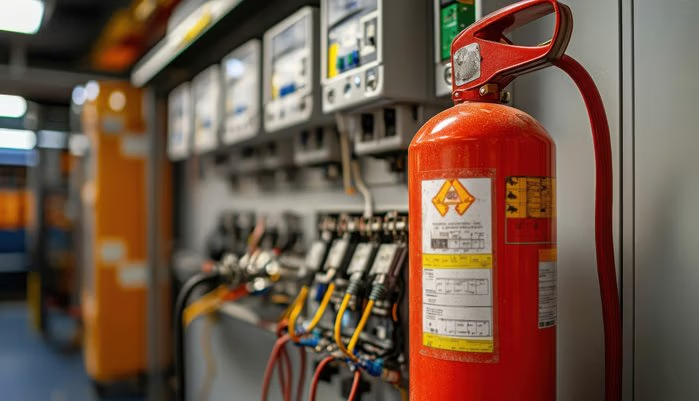Summary: Fire safety inspections are the backbone of workplace safety, especially in high-risk environments like manufacturing plants, warehouses, and commercial buildings, as mandated by local fire regulations such as (in the US) fire marshal compliance requirements, OSHA 1910.39, and NFPA 25 inspection requirements. If you’re an EHS Manager, Compliance Officer, Facility Manager, or Safety Director responsible for fire safety compliance at your facility or across multiple sites, this article shows you how to digitize fire safety inspections efficiently and stay fully compliant. Many organizations still rely on paper forms or outdated Excel sheets – prone to human error, data loss, and compliance gaps. Digitizing fire safety inspections mitigates these risks, strengthens accountability, enables real-time data flow, and boosts operational efficiency. This article covers the most critical checklist items and how to turn them into a streamlined digital process.
The Case for Digitization in Fire Safety
Why go digital?
Fire safety protocols aren’t optional – they’re legally mandated, audit-heavy, and often mission-critical. A missed extinguisher check, outdated fire door, or unlogged drill can expose organizations to devastating consequences.
Challenges of traditional fire safety inspections:
Illegible handwriting and incomplete forms
Manual transcription errors
Delayed reporting and corrective action
Lack of real-time auditability
Poor documentation during compliance checks
Digitizing inspections solves these by:
Creating structured, mobile-ready forms
Automatically timestamping and geo-tagging entries
Enabling instant photo and video evidence uploads
Triggering automated follow-ups for failed checks
Archiving data securely for years
When fire safety documentation can be accessed, verified, and shared in seconds, it becomes a true asset – not a liability.
Are your fire safety inspections fully reliable?
EHS software streamlines inspections, ensuring compliance and safety.
Core Checklist Items: What Must Be Digitized
A proper digital inspection process must be built on a rock-solid checklist. Here are the most critical points every digital fire safety inspection should cover to ensure fire code adherence:
🔥 Fire Extinguishers
Are extinguishers present in all required locations?
Are pressure gauges in the green?
Are inspection tags updated?
Are the units free of damage or corrosion?
Digitize it: Use mandatory photo fields and date-pickers to ensure no skipped visual inspections.
🚪 Fire Doors and Exits
Do fire doors close and latch automatically?
Are exit routes clearly marked and unobstructed?
Are panic bars functional and not blocked?
Digitize it: Include logic that flags missing door photos or blocked paths and requires corrective action logs to comply with fire code.
🚨 Fire Alarm Systems
Is the control panel showing any faults?
Are manual call points accessible and tested as per fire department standards?
Has a recent alarm test been conducted and logged?
Digitize it: Automate test scheduling and escalate unresolved system faults to maintenance immediately.
💡 Emergency Lighting
Are lights operational during power simulations?
Are batteries within the recommended voltage range?
Are logs available for periodic testing?
Digitize it: Use time-based recurrence rules to enforce monthly and annual testing compliance.
🧯 Sprinkler & Suppression Systems
Is water pressure within the target range?
Are sprinkler heads clean and unobstructed to meet fire protection requirements?
Have suppression system cylinders been weighed as part of the fire safety inspection requirement?
Digitize it: Auto-compare readings to standard thresholds; prompt alerts for manual override if critical values are out of range.
📄 Signage & Documentation
Are evacuation maps posted at all required locations?
Are instructions readable and multilingual where needed?
Is the latest inspection record accessible?
Digitize it: Use QR codes linking to digital records at each site and attach high-res photos as visual proof.
👩🏫 Fire Drills & Staff Training
Are drills held at the correct frequency?
Was attendance recorded and feedback gathered?
Are new staff trained within onboarding deadlines?
Digitize it: Automate scheduling and record keeping, and trigger refresher alerts based on hire dates or regulation changes.
How to Build a Fire Inspection Workflow That Works
Digital checklists are only as effective as the workflows surrounding them. A proper fire safety digitalization effort should include:
Preconfigured Templates for Fire Prevention Inspections
Standardized templates ensure consistency across sites while saving time. Templates should be based on local regulatory frameworks (e.g., OSHA, NFPA, ISO 45001).
Mobile-First Interface
Inspectors should be able to complete checks from their phone or tablet – even offline. Offline sync is critical in areas with poor connectivity.
Automated Follow-Ups
Failed items should auto-generate tasks with deadlines. For example, if a fire extinguisher is expired, a task should be assigned to facilities immediately.
Smart Logic & Conditional Checks
Use conditional visibility: only show follow-up questions when needed. E.g., “If alarm test failed, specify reason.”
Real-Time Dashboard
Provide safety officers, plant managers, and auditors with a centralized dashboard that reflects inspection statuses, overdue tasks, and safety trends.
Avoiding Common Pitfalls in Fire Inspection Digitalization
Don’t fall into the trap of “digitizing paperwork.” Taking your existing paper form and stuffing it into a PDF app isn’t digital transformation – it’s digital substitution. To gain real value:
Avoid free-text fields where possible – use dropdowns, checkboxes, and automated logic.
Don’t delay automation – set up real-time alerts and reminders from day one.
Focus on data reusability – use the data you collect to inform safety KPIs, heatmaps, and recurring issues.
Compliance Isn’t Optional – Make It Effortless
Regulatory frameworks vary, but most include similar components: documented inspections, logged incidents, and proof of training. Digitization makes compliance far less burdensome by:
Keeping a time-stamped audit trail for every inspection
Generating downloadable reports in PDF/Excel formats
Proving corrective actions were taken within deadlines
Simplifying third-party audits or insurer reviews
When your fire safety program runs digitally, compliance is no longer a scramble – it’s automatic.
Digital Fire Safety in Action: Practical Example
Example: One of our customers in logistics, managing 12 warehouse sites, adopted a mobile app integrated with their EHS software to digitize fire safety inspections and enhance overall warehouse safety. Within six months, they achieved:
A 45% reduction in missed inspection tasks
Saved an average of 2.5 hours per week in administrative work per site
Maintained 100% up-to-date compliance documentation, enabling smooth surprise audits
This transition didn’t just improve efficiency – it gave them reliable oversight and peace of mind in fire safety management.
Final Thoughts
Digitizing fire safety inspections is more than an upgrade – it’s a safeguard. By moving to a digital-first approach, you not only reduce risk and human error but also empower your teams to act faster and with more clarity.
🔒 Ready to Secure Your Fire Safety Processes?
flowdit helps you digitize your entire fire safety inspection process - from mobile-ready checklists to real-time dashboards and automated compliance reports. Whether you're running a single plant or managing dozens of facilities, flowdit gives you the structure, clarity, and accountability your teams need to stay safe - and stay compliant.
👉 Schedule your free demo today and see how flowdit can make your fire safety inspections faster, safer, and fully compliant.
FAQ | Fire Safety Inspection
What is a fire safety inspection and why does it matter?
A fire safety inspection is a systematic examination of a building’s fire protection systems, procedures, and compliance with fire safety codes and standards. The importance of these inspections lies in their role in identifying potential fire hazards, ensuring compliance with fire codes, and ultimately protecting lives and property from fire-related incidents. Regular inspections help maintain public safety and ensure that facilities adhere to local fire regulations and state fire requirements.
What is a fire risk assessment?
A fire risk assessment identifies and evaluates potential fire hazards, ignition sources, and occupant vulnerabilities. It prioritizes risks and recommends measures to eliminate or reduce fire dangers, forming the basis for fire prevention and emergency planning.
How do fire safety inspections contribute to effective fire prevention?
- Identifying hidden risks like faulty wiring, overloaded circuits, or improper chemical storage before ignition.
Verifying maintenance of fire detection and suppression systems to ensure they activate promptly.
Evaluating building conditions, including clear evacuation routes and fire-resistant materials.
Reviewing staff training and emergency readiness to reduce human error during fire incidents.
Providing actionable reports that prioritize preventive measures and continuous improvements.
What common fire hazards are found during inspections?
Damaged or exposed electrical wiring causing sparks.
Blocked or unclear emergency exit routes.
Expired or non-functional fire extinguishers.
Unsafe storage of flammable liquids or chemicals.
Dust and debris buildup near ignition sources.
Faulty fire alarms and detectors.
Overloaded electrical circuits.
Poorly maintained sprinkler and suppression systems.
What fire safety equipment should I have in my facility?
Fire extinguishers suitable for different fire classes (A, B, C, D, K) placed at accessible locations.
Smoke and heat detectors connected to a reliable fire alarm system.
Automatic sprinkler systems covering high-risk zones and common areas.
Emergency lighting and illuminated exit signs to guide safe evacuation during power outages.
Fire blankets and hose reels where appropriate, especially in kitchens or workshops.
Fire doors and barriers that contain fire spread and protect escape routes.
Manual call points (fire alarm pull stations) for immediate alarm activation.
What belongs in a fire safety plan?
- Detailed evacuation routes and assembly points to guide occupants safely out of the building.
Roles and responsibilities for fire wardens, safety officers, and staff during an emergency.
Fire detection and alarm system details, including maintenance and testing schedules.
Fire suppression equipment locations and instructions for use.
Procedures for reporting fires and alerting emergency services.
Training and drill schedules to ensure preparedness.
Hazard identification and risk mitigation strategies tailored to the facility’s specific fire risks.
How can companies prepare for an external fire safety inspection?
Collect all maintenance and inspection records for fire alarms, extinguishers, sprinklers, and emergency lighting.
Clear access to all fire safety equipment and exits to allow unobstructed inspection and testing.
Perform internal pre-checks to identify and fix obvious issues before the inspector arrives.
Brief employees on emergency procedures and fire safety protocols so they can confidently answer questions and demonstrate readiness.
Verify signage and emergency lighting functionality to meet visibility standards.
Ensure hazardous materials are stored according to regulations and properly labeled.
What checklist points should a digital fire safety inspection include?
When creating a digital checklist for fire safety inspections, essential points to include are:
- verifying the functionality of fire alarm systems
- checking the condition of fire extinguishers
- ensuring emergency lighting
- inspecting sprinkler systems, reviewing fire protection systems.
Additionally, the checklist should cover compliance with fire prevention codes, assessment of hazardous materials, and ensuring proper exit signage is in place.
How can the fire safety inspection process be digitized?
Digitizing the process of conducting fire safety inspections involves using technology to streamline data collection, reporting, and analysis. This can include utilizing mobile applications that allow inspectors to input data directly on-site, take photos of fire hazards, and generate digital reports.
What software options exist for digital fire safety inspections?
Available software ranges from dedicated inspection management tools to property management systems with inspection modules, offering customizable checklists, automated scheduling, reporting, real-time data analysis, and compliance tracking.
Image: Adobe Stock – Copyright: © Iurii – stock.adobe.com





